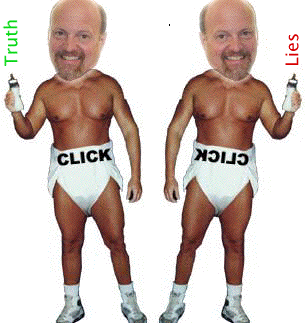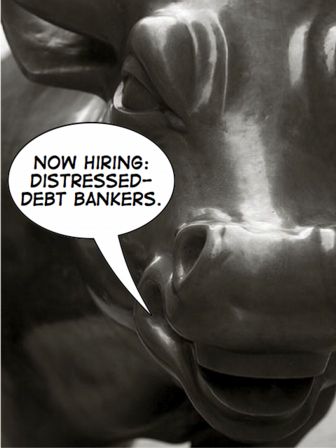 |
The stock and credit markets are finally topping out. Have institutions pulled out as retail investors keep piling in? That's what happened last time, before the stock bubble burst in 2000.
We start off today's News with a curious piece by our old nemesis JJ Cramer in New York Magazine, Cramer vs. Cramer. It's long, six pages: two parts self-flagellation, one part bragging, and three parts justification. In sum, he says the reason he, an industry insider, takes the time to give away the hard earned secrets of Wall Street to his viewers for free is because he's insecure and needs to constantly prove that he's right. While the show teaches his viewers how to get rich picking stocks, for him–already rich from his hedge fund and needing no additional income–it's therapy to feed his know-it-all, look at me, Ma, neuroses. He concludes by appealing to his critics for pity: "For the people who still can’t stand me, anything I do, or what I claim to stand for, I can offer only one thing. Despite the fact that wherever I go I get asked for my autograph, and if I stop for too long I end up getting my picture taken with a dozen strangers, I remain completely and utterly repulsive to myself."
In six pages he does everything except demonstrate that he's interested in understanding why some people don't like him: because he's full of shit.
Let's give him the benefit of the doubt. Maybe he is instructing his viewers these days to bet with Wall Street institutions, to which he has connections, instead of walking his viewers off the gang plank into the Wall Street shark tank the way he did in 2000. Is it possible that Cramer, the industry insider, back then simply didn't know Who Drove and Burst the Tech Bubble? This analysis was published August 16, 2005, the result of research by JOHN M. GRIFFIN, JEFFREY H. HARRIS, AND SELIM TOPALOGLU. Griffin is at the University of Texas at Austin, Harris is at the University of Delaware and a former Nasdaq Visiting Academic Fellow, and Topaloglu is at Queen’s University.):
During March 2000 institutional investor groups steadily pulled capital out of the market, while individual investors continued to buy in. Peaks in individual securities not in March 2000 coincide with institutional investors buying along with discount brokerage clients and other individual investors. Collapses in these stocks reflect a rapid flight of institutional capital that, with the combination of falling prices, was offset by continued purchases from discount brokerage clients and other individuals.
Overall, our results do not support bubble models where individuals move market-wide prices and institutions (smart money) passively stand by. The patterns of institutional investors driving price increases, institutions following the trading of other institutions, and institutions rapidly reversing course with the crash are all consistent with the Abreu and Brunnermeier (2003) model. An alternative explanation is that institutions drove prices higher over this period because of their rational belief in tech stock future growth opportunities or because they were irrationally affected by euphoria. However, patterns of a) institutional investors following the trading of other institutions and individuals at the market level and b) strong individual investor buying followed by rapid institutional buying pressure prior to individual stock peaks seem difficult to explain with institutional investors setting prices solely based on their calculations of fundamentals. Future research should explore the underlying motivations of institutional investor trading with respect to short-term market conditions.
Maybe they wanted to leave individual investors holding the bag? Just a guess. Overall, our results do not support bubble models where individuals move market-wide prices and institutions (smart money) passively stand by. The patterns of institutional investors driving price increases, institutions following the trading of other institutions, and institutions rapidly reversing course with the crash are all consistent with the Abreu and Brunnermeier (2003) model. An alternative explanation is that institutions drove prices higher over this period because of their rational belief in tech stock future growth opportunities or because they were irrationally affected by euphoria. However, patterns of a) institutional investors following the trading of other institutions and individuals at the market level and b) strong individual investor buying followed by rapid institutional buying pressure prior to individual stock peaks seem difficult to explain with institutional investors setting prices solely based on their calculations of fundamentals. Future research should explore the underlying motivations of institutional investor trading with respect to short-term market conditions.
In the case of Cramer, either he was an insider who knew what was going on and failed to warn his viewers for some reason, or wasn't an insider and was therefor not accurately representing himself. If he is interested in helping his viewers with stocks today, he can do so by getting them out of the market before it crashes again. While the patterns of trades cannot be measured in real time to tell us if institutions are getting out again–either that or Griffin et al ain't telling us (we asked)–some changes in behavior are telling. Stocking up on distressed debt specialists in Europe is one indicator. No story yet on investment banks hiring distressed debt specialists in the US, but can they be far behind?
(Jim, if you're reading this, you can count us among those who like it when you wear a diaper or swim in the pool of lettuce. How about combining the two–swim in a pool of lettuce wearing a diaper? That said, we will always take your side against your obnoxious anti-semitic detractors.)
 |
May 30, 2007 (Bloomberg)
The biggest winners from the global buyout boom are hiring distressed-debt bankers in Europe at the fastest pace in five years.
Goldman Sachs Group Inc., the world's most profitable securities firm, hired Andrew Wilkinson, the lawyer who advised creditors in the bankruptcies of Eurotunnel Plc and Parmalat Finanziaria SpA, to help lead its restructuring business in London. Morgan Stanley, the third most-active merger adviser this year behind Citigroup Inc. and Goldman, added seven bankers in the past year, boosting its group to 61. Blackstone Group LP, poised to become the world's largest publicly traded buyout firm, is starting a corporate restructuring group in Europe.
"When the turn does come, it will be unlike anything we have ever seen before," said Iain Burnett, 43, managing director of Morgan Stanley's special situations unit in London. "The scale of it could be considerable because of the size of some of these leveraged deals," said Burnett, who began his career in London a month before the October 1987 stock market crash.
It's possible investment banks need a pack of distressed debt experts without the stock market tanking, but that doesn't seem likely.
A top in the credit cycle has been called several times over the past few years. The first time I heard the the credit bubble top called was in 2002 when I was meeting with an investment banker in London. "It ain't gonna be pretty what that thing busts," I recall him saying. Five years and a few trillion in corporate debt later, the credit bubble is still going strong. Also heard a top called by a managing partner of a very large private equity firm two years ago. Doubtful that the bust will be any prettier for the extra innings that the game has gone on.
Credit market 'bubble' may be at bursting point
May 30, 2007 (Mark Gilbert - Bloomberg News)
As the reasons for concern accumulate, strategists are starting to reach for their bear suits.
"We are growing extremely negative on credit markets, which we see as in a bubble," Tim Bond, head of asset allocation at Barclays Capital in London, wrote this week. "U.S. companies are releveraging aggressively in an attempt to substitute earnings-per-share growth for earnings growth. 2008 should see a fairly savage bear market for credit, a large rise in defaults and an end to easy liquidity conditions."
Dresdner Kleinwort's analysts, led by Willem Sels, the head of credit strategy, in London, scrutinized U.S. earnings growth in the past quarter. They concluded that the average figure of 12.5 percent was misleading because it measured earnings per share and was distorted by stock buybacks.
Profit growth for the companies in the Standard & Poor's 500 index is just 9 percent, and 3 percent for all U.S. companies. "With net debt growing at 10 percent, leverage ratios are deteriorating," the Dresdner team wrote in a report this week. "Clearly this is not in line with unchanged credit spreads."
Profit growth just 9% for the companies in the Standard & Poor's 500 index while the index picked up 19%? May 30, 2007 (Mark Gilbert - Bloomberg News)
As the reasons for concern accumulate, strategists are starting to reach for their bear suits.
"We are growing extremely negative on credit markets, which we see as in a bubble," Tim Bond, head of asset allocation at Barclays Capital in London, wrote this week. "U.S. companies are releveraging aggressively in an attempt to substitute earnings-per-share growth for earnings growth. 2008 should see a fairly savage bear market for credit, a large rise in defaults and an end to easy liquidity conditions."
Dresdner Kleinwort's analysts, led by Willem Sels, the head of credit strategy, in London, scrutinized U.S. earnings growth in the past quarter. They concluded that the average figure of 12.5 percent was misleading because it measured earnings per share and was distorted by stock buybacks.
Profit growth for the companies in the Standard & Poor's 500 index is just 9 percent, and 3 percent for all U.S. companies. "With net debt growing at 10 percent, leverage ratios are deteriorating," the Dresdner team wrote in a report this week. "Clearly this is not in line with unchanged credit spreads."
Speaking of fictitious value, today we published Fueling the FIRE Economy - Part III: Impact of Disappearing Fictitious Value. Curious to know how many trillions of dollars of fictitious value the real estate and other markets have picked up since the global reflation program started in 2001 and what that means for the US economy and markets? iTulip Select subscribers can read about it here. If you are not a subscriber, you can sign up here.
The truly disturbing news today is a development related to the alternative energy bubble, now in its formative, pre-bubble phase.
 |
Mexican farmers burning agave fields and replanting them with corn
May 27, 2007 (MSNBC)
Mexican farmers are setting ablaze fields of blue agave, the cactus-like plant used to make the fiery spirit tequila, and resowing the land with corn as soaring U.S. ethanol demand pushes up prices.
How's this for a long-short fund idea: short General Motors, long Pedron and Herradura.

Comment